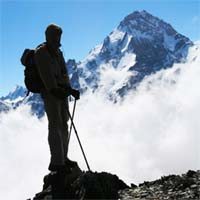Mesothelioma Death: Asbestos Was Climber’s Greatest Risk

An Australian mountain climber who made headlines in 2006 by surviving a harrowing experience on Mt. Everest has died of mesothelioma.
Fifty-six year old Lincoln Hall had climbed many of the world’s highest peaks, including Mt. Everest in 2006. But when he developed serious symptoms of oxygen deprivation on the way down, he was left for dead by his climbing team. An American guide and his two clients found Hall the next day and sacrificed their own summit experience to save his life. After treatment in a Nepal hospital for a chest infection, fluid on his brain and frostbite, Hall eventually returned to Australia where he was hailed as a hero.
Despite the risks Hall took in his life, including his brush with death on Everest, it was the mineral asbestos that proved to be his most dangerous encounter. Asbestos is the primary cause of the rare malignancy called mesothelioma. According to the Associated Press, Hall came in contact with asbestos while doing construction work early in his life. Once asbestos is inhaled or ingested, the sharp fibers stay in the body indefinitely, causing chronic irritation that can lead to mesothelioma as many as 40 or 50 year later.
Because of the heavy use of asbestos in building products, especially those manufactured before the 1980’s, construction workers make up a large portion of the world’s mesothelioma victims. Like Hall, many did not even work in the industry for very long. Late last year, Australian actor Harold Hopkins died of mesothelioma, which he also believed was the result of construction work in his teens. The same was true for American actors Merlin Olsen, who died of mesothelioma in 2009, and Steve McQueen, who was just 50 years old when he died of mesothelioma in 1980.
There is some evidence that the early exposure to asbestos in all of these cases may have put these men at higher risk of mesothelioma later in life. A French population study published in 2011 found that the risk of mesothelioma was lower for subjects who were first exposed to asbestos after the age of 20. The study tracked more than 2,466 asbestos-exposed men and was published in the European Respiratory Journal.
Lincoln Hall wrote books and articles about his climbing experiences and has photos published in climbing magazines. He also established the Australian Himalayan Foundation which raised money for schools in the Himalayas and was devoted to the caused until he died. He was represented by the Australian mesothelioma law firm of Maurice Blackburn Pty Limited in his asbestos-mesothelioma lawsuit. Hall is survived by his wife and two sons.
Sources:
“Australian mountaineer Lincoln Hall, left for dead near Everest peak in 2006, dies of cancer”, Associated Press report, published in the Washington Post, March 21, 2012.
Lacourt, A et al, “Temporal patterns of occupational asbestos exposure and risk of mesothelioma”, November 10, 2011, European Respiratory Journal, Epub ahead of print.





